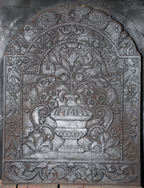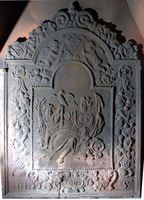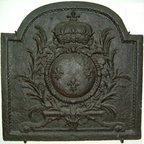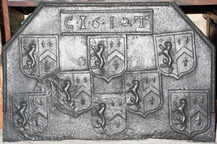-
1034
Description: Canted rectangular shape; twisted rope edging in short lengths (top and sides); shield stamp with rebated edges repeated five times (two and three).
Notes: The arms are those of Courthope of Whiligh in Ticehurst; blazon: argent, a fess azure between three estoiles sable (two and one). Shown are molets of six points which have straight rays instead of (properly) estoiles which have wavy ones. However, the 1643/4 iron graveslab of David Barham of Snape, in Wadhurst church, has the same arms (also with molets instead of estoiles), which were those of his mother who was a Courthope.
Arms: Courthope, of Whiligh in Ticehurst
- Decoration tags:
- rectangular with canted top corners (shape)
- rope (edging)
- carved stamps
- heraldic
- armorial
Manufactured: in the late-16th to early-17th century in the Weald area of England.
Current location: Fulham, London, England.
- Attached to series:
- Personal armorial firebacks
- Courthope arms series
-
516
Description: Arched rectangular central panel with bead-and-pellet edging; on a ground between two plants, a gadrooned flower vase with two, scrolled handles, tulips and other flowers issuing from the narrow neck; arched rectangular border with fillet edging; mirrored descending flower swags; along a rectangular bottom panel with fillet edging a symmetrical arrangement of swirled foliage; on top, two mirrored sea serpents.
Notes: The presence of tulips suggest a Dutch origin for the pattern of this fireback, although the presence of several examples in England suggest that it was produced here rather than on the Continent.
Copies of this fireback are known.
- Decoration tags:
- 'Dutch' (shape)
- fillet (edging)
- whole carved pattern
- planklines
- pictorial
- plants
- objects
Manufactured: in the late-17th century in England.
Current location: Penshurst Place, Penshurst, Kent, England.
- Attached to series:
- Flower Vase 'Dutch' types
- British 'Dutch' style firebacks
-
586
Description: Arched rectangular shaped central panel with bead edging; pictorial scene of a seated female figure resting against a hurdle, holding an anchor, a child on each side of her, the one on the left standing clutching corn stalks, the one on the right sitting also holding the anchor and a circular object; a bird sits on a post; arched rectangular border with bead edging; fructal and floral festoons suspended on ribbons with two putti at the top and two on each side; in the left and right bottom corners, the initials 'HH' and 'S' respectively; at the bottom, a central cartouche with date, between floral swags; on top, twin spirals between descending floral festoons.
Notes: The figure is an allegory of Hope. The theft in 1699 from a Thames-side warehouse of several firebacks, including '3 of Hope with an Anchor' may refer to this type (Post Boy 11-14 Nov. 1699).
Copies of this fireback are known.
Inscription: HH 1665 S
- Decoration tags:
- 'Dutch' (shape)
- ovolo (edging)
- whole carved pattern
- pictorial
- allegorical
- text
- animals
- humans
- objects
Manufactured: in 1665 in the Siegerland area of Germany.
Current location: in private hands, Plaxtol, Kent, England.
- Attached to series:
- 'Dutch' HHS series
- Hope firebacks
-
765
Description: Arched rectangular; fillet edging with darts on the inside; circular arms of France within the chains of the Ordre d'Esprit and the Ordre de St Michel, with crown above, all resting on a framework compartment, with olive leaf sprays on each side ofn the shield.
Notes: Typical form of the arms of France of the period of Louis XIV.
Arms: France modern
- Decoration tags:
- rectangular with round arch (shape)
- fillet (edging)
- whole carved pattern
- armorial
- royal
Manufactured: in the late-17th to early-18th century in France.
Current location: Victoria & Albert Museum, Cromwell Road, Kensington & Chelsea, Greater London, England.
Museum number: M.1132-1926 (part of the Victoria & Albert Museum museum group)
Citation: Carpentier, H., 1912, Plaques de Cheminées (Paris, published by the author).
- Attached to series:
- Foreign armorial firebacks
-
1192
Description: Canted rectangular shape; twisted rope edging formed of six lengths of 23cm (top and sides); top centre, rectangular panel with cavetto-moulded edging (left side missing) enclosing date between initials CT, all interposed with dots; below, eight shields of Ayloffe impaling Sulyard in three rows (3-2-3); Ayloffe: sable, a lion rampant Or, collared gules, between three crosses formy of the second; Sulyard: argent, a chevron gules between three pheons inverted sable.
Notes: William Ayloffe (c1535-1584) of Bretons, Hornchurch, Essex, Justice of the Court of Queen’s Bench, married (c1560) Jane, dau. of Sir Eustace Sulyard, of Runwell, Essex. The initials 'CT' are likely to be those of Charles Tyler, a founder whose working life and that of his family have strong parallels with the occurrence of these firebacks. The excrescence affecting the left shield in the middle row and the blemish left of the middle shield in the top row are the result of inexpert ladling of the iron during casting. Previously at Smarden, Kent. The absence of the left side of the frame of the inscription panel has also been noted on another back in this series, also dated 1612.
Inscription: C.1.6.1.2.T
Arms: Ayloffe impaling Sulyard (William Ayloffe of Bretons, Hornchurch)
- Decoration tags:
- rectangular with canted top corners (shape)
- rope (edging)
- carved stamps
- individual letters
- individual numbers
- heraldic
- armorial
- text
Manufactured: in 1612 possibly at Bedgebury Furnace, Goudhurst in the Weald area of England.
Current location: in private hands, Crawley, West Sussex, England.
- Attached to series:
- Ayloffe series
- Personal armorial firebacks




